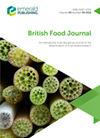The effect of nutrition labels on lunch buffet consumption: a real-life experiment
IF 3.4
3区 经济学
Q1 AGRICULTURAL ECONOMICS & POLICY
引用次数: 0
Abstract
PurposeThis study aims to increase knowledge of the ability of nutrition labels to guide consumer choices in real-life environments.Design/methodology/approachFood consumption and plate waste data were collected from two self-service restaurants (SSR) with different customer groups over six observation days: three control and three intervention (with nutrition labelling) periods. Study Group 1 consisted of vocational school students, mostly late adolescents (N = 1,710), and Group 2 consisted of spa hotel customers, mostly elderly (N = 1,807). In the experimental restaurants, the same food was served to the buffets during the control and intervention periods.FindingsThe nutrition label in the lunch buffet guides customers to eat fewer main foods and salads and to select healthier choices. Increased consumption of taste enhancers (salt and ketchup) was observed in the study restaurants after nutritional labelling. Nutrition labelling was associated with a reduction in plate waste among the elderly, whereas the opposite was observed among adolescents.Originality/valueThe results provide public policymakers and marketers with a better understanding of the effects of nutrition labelling on consumer behaviour. Future studies should further evaluate the effects of nutrition labelling on the overall quality of customer diets and the complex environmental, social, and psychological factors affecting food choices and plate waste accumulation in various study groups.营养标签对自助午餐消费的影响:一项真实实验
设计/方法/途径在两个自助餐厅(SSR)的六个观察日中收集了不同顾客群体的食品消费和餐盘垃圾数据:三个对照组和三个干预组(有营养标签)。研究组 1 由职业学校学生组成,其中大部分为青少年(人数 = 1,710);研究组 2 由温泉酒店顾客组成,其中大部分为老年人(人数 = 1,807)。在实验餐厅,对照组和干预组的自助餐供应相同的食物。研究结果自助午餐的营养标签引导顾客少吃主食和沙拉,选择更健康的食物。研究发现,贴上营养标签后,餐厅中增味剂(盐和番茄酱)的消费量有所增加。在老年人中,营养标签与减少餐盘浪费有关,而在青少年中则相反。未来的研究应进一步评估营养标签对消费者饮食整体质量的影响,以及影响不同研究群体食物选择和餐盘垃圾累积的复杂环境、社会和心理因素。
本文章由计算机程序翻译,如有差异,请以英文原文为准。
求助全文
约1分钟内获得全文
求助全文
来源期刊

British Food Journal
工程技术-食品科技
CiteScore
6.90
自引率
15.20%
发文量
219
审稿时长
18-36 weeks
期刊介绍:
After 115 years, the British Food Journal (BFJ) continues to be highly respected worldwide for its broad and unique interdisciplinary coverage of the latest food-related double blind peer-reviewed research. It links all sectors of this dynamic industry, keeping abreast of emerging trends, topical and controversial issues and informing and stimulating debate. - See more at: http://emeraldgrouppublishing.com/products/journals/journals.htm?id=bfj#sthash.O3wH4pEh.dpuf
 求助内容:
求助内容: 应助结果提醒方式:
应助结果提醒方式:


